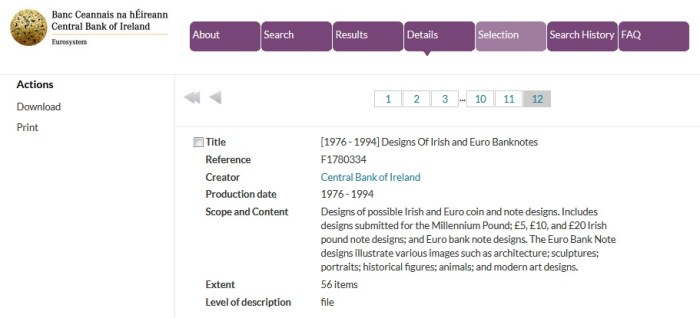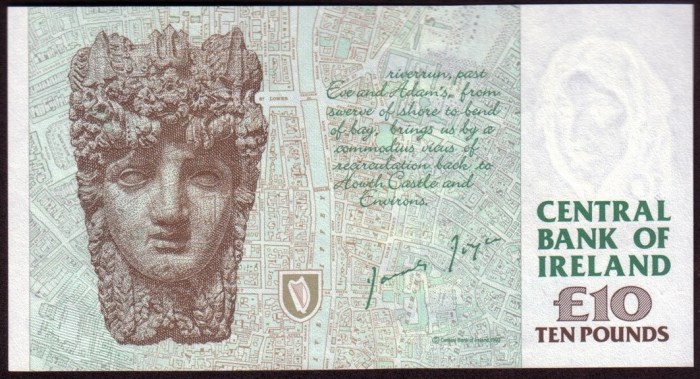Upon hearing the news that “The Central Bank of Ireland has opened its archives to the public” I just had to book an appointment for a quick, initial visit … and I was not disappointed !
The Central Bank of Ireland has employed a professional archivist and the fruits of this investment can be seen in the form of a modern reading room, with access to previously unobtainable documents and ledgers dating from 1786 to 1986. I have no doubt that the contents of same will be cited in scholastic articles for decades to come. With so many of the records of the British Administration in Ireland destroyed by fire in The Customs House (25 May 1921) and The Four Courts (30 June 1922), many of the earlier Central Bank archive items are priceless !

A beautifully preserved, leather-bound ledger from the Central Bank of Ireland Archive “Imports & Exports of Ireland for the Year Ending 25 March 1786”. Just one of the many hundreds of fiscal and statistical treasures now available for academic research, at North Wall Quay.
From the moment I walked into the Central Bank of Ireland’s stunning new premises at North Wall Quay, I was impressed by the combination of a professional, high security environment and warm, friendly welcome by the staff. The new Archive Reading Room welcomes both economic and numismatic researchers alike. It is not a museum and some of the artifacts may be a bit too specialist for the casual observer, but the range, quantity and quality of the materials is stunning. That said, the Central Bank has a backlog of items for archival, recording and preservation – and boxes are still being discovered at Sandford !
I only had a short time to explore and the archivist had very kindly arranged a small range of objects for my perusal. Since my interest lies in numismatics and notophily, a display of relevant coins and banknotes were set out in advance.
It is important to note
- The Bank’s archive policy was approved in 2016, in which we have adopted our own rules for transfer of records by Bank divisions to the archive and a 30-year rule for releasing archives to the public.
- The Bank has developed an online catalogue of the archival materials we hold to allow the public to search online and identify what they would like to consult, along with booking appointments online to access the archival materials in the reading room.
- The archives are a constant ‘work in progress’ and are being constantly updated.
- The archives themselves are not online but an online catalog is available.
- These archives ‘currently’ comprise :-
- 12,000+ paper files dating from the foundation of the currency commission in 1927; and the Bank from its inception in 1943.
- 4,000+ photographic prints.
- 560+ architectural plans and drawings including the various premises owned or purchased by the Bank, such as Foster Place; Fitzwilliam House, College Green, and Dame St.
- 250+ bound ledgers. These include two smaller collections: namely a portion of the Free State and later Republic of Ireland Land Commission bonds and the archives of the Commercial Building Company.
In normal circumstances, I would have done the following :-
- Searched and/or browsed the online catalogue
- Noted the reference number(s) + number of items (if more than 1)
- Booked an appointment
- And noted the reference number(s)
Example:

Searching the new Central Bank of Ireland Archive “online catalogue” is easy and this is an example of a search for “banknote design.” Due to the ’30 year rule’, not all items are available for viewing and some items flag an ‘earliest viewing date’ well into the future.
The above search yielded 12 items and the item I was looking for has “56 items” in a physical file. The archivist would normally require advance notice to retrieve the items and get them ready for the visit – hence the advance booking system.
Now it just so happens that one of the items set out in the display for my initial visit was some physical records of the potential designs for the reverse of the “C Series” ten pound banknote – a.k.a. the James Joyce £10 note. They give an insight into the number of design iterations, feedback loops and changes a banknote goes through before the finished product hits the ATMs, banking halls and shops.

An early design iteration for the “C Series” James Joyce £10 banknote. Notice the various edits and suggestions, plus the skyline of Dublin design. These changes would have been fed back to the design team – including the artist (Robert Ballagh) and engravers

Having received the first set of feedback from its initial “C Series” James Joyce £10 banknote design, the design team changed the colour to green and made a few adjustments to the text.
I wonder what the ‘thought processes’ were during the iterative phases of design. In 1993, around the same time that the Irish Republic joined the European Union, the Bank of Ireland re-issued their paper money, including James Joyce on the ten-pound note. The people depicted on the “C Series” are different to those they replaced, i.e. the “B Series” and nowhere is the more apparent than the cultural identities imbued by those of WB Yeats and James Joyce – the former being a figure of a cultural de-colonization and anti-colonial nationalism, and the latter – a rebellious, erstwhile heretical persona who later became a consolidating figure for a late twentieth-century discourse of post-nationalism.

By the time the “C Series” James Joyce £10 banknote actually went into circulation, the reverse design is very different from the two earliest formats in the Central Bank of Ireland’s Archive – it now features one of the heads on The Custom House, Dublin, a nineteenth century map and some text from one of Joyce’s better known plays “Finnegans Wake”
The materials give a fascinating glimpse into the design iterations that go into the overall design process – from initial concept, through editing, security requisites, printing limitations and final design. The two very different sides of the James Joyce “tenner” is perhaps a metaphor for Tom Nairn’s celebrated description of the ambivalence of nationalism as “Janus-faced”: one side healthy, rational, modern; the other side morbid, irrational, ancestral.
I wonder what the “minutes” of the design meeting say? Are the two sides of this banknote a compromise in terms of how we (the Irish) see ourselves … then and now?
Getting back to the review, I was a bit over-awed by the large volume of information and range of the artefacts. There was simply too much to include in just one article, so I am looking forward to many visits – each one with a specific question to answer.
By way of a formal review, my remarks are as follows :-
Facilities
- Online Database
- intuitive, easy to use, fast
- Reading Room
- small, but there won’t be big crowds in there (academic researchers)
- modern, well-lit and very comfortable
- Materials
- it has to begin somewhere and is very difficult to predict what people will request – that said – this is a “very impressive” beginning and they will improve as more materials becomes available + researchers put in requests for items not found on the online database.
- very professional setup, with a professional archivist in attendance
- Accessibility
- everything is on the ground floor, so wheelchair access is excellent
- small café in foyer but be warned – debit/credit cards only – no cash !
Staff:
- Product knowledge
- 10/10
- Diligence
- 10/10
- Enthusiasm
- 10/10
Conclusions:
- From now on, no scholarly article can be written on modern Irish numismatic and/or notophilic history without a visit (or two) to this archive.
- From an economics and political viewpoint, it will be especially interesting to see how people interpret the Joseph Brennan and T.K. Whitaker legacy in the light of new insights re The Central Bank of Ireland’s archive materials.










I have visited the Central Bank archives a couple of times – perfect for my research into Irish banknote history. Even better would be access to the Bank of Ireland’s extensive archives which cover their whole history from 1783 onwards. Any chance of that? I even wrote to their CEO but they have no archivist and no plans to hire one.
LikeLike
Hi Jonathan,
The Bank of Ireland is a very different type of organisation to the Central Bank.
I’ve read your book on Irish Banknotes and, if I was to recommend anyone to gain access,
you would definitely be on the list.
Sadly, I have even less influence than you.
Best of luck with your future research,
James
LikeLike